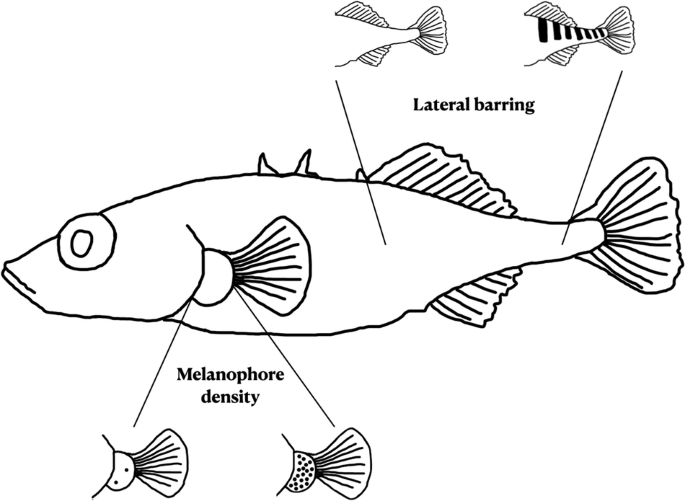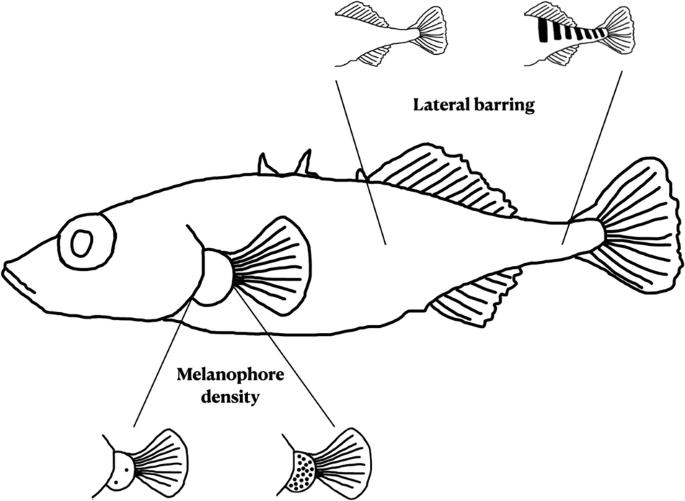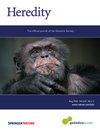底栖三刺鱼和湖泊三刺鱼黑色素差异的遗传基础。
IF 3.9
2区 生物学
Q2 ECOLOGY
引用次数: 0
摘要
色素是研究进化变化模式的绝佳性状,因为它经常处于自然选择之下。底栖三刺鱼和底栖三刺鱼(Gasterosteus aculeatus)表现出不同的色素表型,这可能是为了适应不同的生境。脊椎动物色素沉着的遗传结构似乎很复杂。先前对三刺鱼色素表型的 QTL 图谱已确定了几个候选位点。然而,相对于其他形态表型(如刺或侧板),三刺鱼色素沉着的遗传结构仍未得到充分研究。在此,我们利用底栖-近缘F2杂交对两个黑色素沉着性状(黑色素鞘密度和侧条纹)进行了QTL图谱绘制。这两个性状映射到不同的染色体上,表明它们有不同的遗传基础。由此产生的 QTLs 具有加性,但对总变异的解释相对较小(约 6%)。QTLs图谱因F1家族而异,表明遗传结构或检测小效应位点的能力存在差异。功能分析确定了候选基因座的富集途径。由此产生的几个色素沉着候选位点,包括富集通路中的三个位点(bco1、sulf1 和 tyms),以前曾被指出影响其他脊椎动物的色素沉着。越来越多的证据表明,色素沉着通常是多基因遗传的。本文章由计算机程序翻译,如有差异,请以英文原文为准。


The genetic basis of divergent melanic pigmentation in benthic and limnetic threespine stickleback
Pigmentation is an excellent trait to examine patterns of evolutionary change because it is often under natural selection. Benthic and limnetic threespine stickleback (Gasterosteus aculeatus) exhibit distinct pigmentation phenotypes, likely an adaptation to occupation of divergent niches. The genetic architecture of pigmentation in vertebrates appears to be complex. Prior QTL mapping of threespine stickleback pigmentation phenotypes has identified several candidate loci. However—relative to other morphological phenotypes (e.g., spines or lateral plates)—the genetic architecture of threespine stickleback pigmentation remains understudied. Here, we performed QTL mapping for two melanic pigmentation traits (melanophore density and lateral barring) using benthic-limnetic F2 crosses. The two traits mapped to different chromosomes, suggesting a distinct genetic basis. The resulting QTLs were additive, but explained a relatively small fraction of the total variance (~6%). QTLs maps differed by F1 family, suggesting variation in genetic architecture or ability to detect loci of small effect. Functional analysis identified enriched pathways for candidate loci. Several of the resulting candidate loci for pigmentation, including three loci in enriched pathways (bco1, sulf1, and tyms) have been previously indicated to affect pigmentation in other vertebrates. These findings add to a growing body of evidence suggesting pigmentation is often polygenic.
求助全文
通过发布文献求助,成功后即可免费获取论文全文。
去求助
来源期刊

Heredity
生物-进化生物学
CiteScore
7.50
自引率
2.60%
发文量
84
审稿时长
4-8 weeks
期刊介绍:
Heredity is the official journal of the Genetics Society. It covers a broad range of topics within the field of genetics and therefore papers must address conceptual or applied issues of interest to the journal''s wide readership
 求助内容:
求助内容: 应助结果提醒方式:
应助结果提醒方式:


